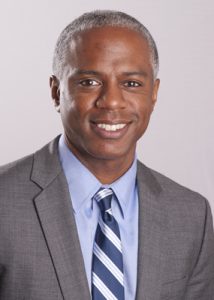SLIS Leader: Daren Hubbard
 Daren Hubbard is Chief Information Officer and Associate Vice President for Computing and Information Technology at Wayne State University. He has over 20 years of experience in higher education leadership. He is a certified project manager and has an MBA and MLIS ('00) from Wayne STate University.
Daren Hubbard is Chief Information Officer and Associate Vice President for Computing and Information Technology at Wayne State University. He has over 20 years of experience in higher education leadership. He is a certified project manager and has an MBA and MLIS ('00) from Wayne STate University.
As CIO of Wayne State University, you are responsible for the university's computing and networking facilities, data center operations, enterprise software applications, learning management environments, high-performance research computing, voice services, information security, and information technology support services. How do you stay up-to-date on current trends in those areas? Are there online resources, periodicals, or other media outlets that you would recommend on those topics?
I tend to rely on multiple websites and information sources to keep up like cio.com, informationweek.com and campus technology. We also read the chronicle of higher education as well to stay aligned with the academe. I encourage my team to do the same to ensure that we have a variety of perspectives at the table. I also look to several outlets that cover consumer technology like engadget.com and theverge.net to track larger tech trends. And finally I take note of how my children are using technology to anticipate emerging trends.
You also manage an extensive staff. Can you share a little bit about how you and your team communicate goals and priorities to ensure that the many projects you work on maintain forward progress?
Much of what we do centers around communicating early and often. Weekly, bi-weekly, and monthly meeting with multiple levels of management and staff is a must. And all of that is supplemented by communications from my office via email, portal or through the website. And finally, I perform skip-level meetings to engage directly with all staff to hear from all corners of the division.
You earned your MLIS from Wayne State in 2000. How has your MLIS contributed to your work as CIO?
The most important contribution would be the skill to acquire new knowledge and be able to quickly integrate it and leverage it for alternative purposes. This is something that librarians have been doing for years that is critical to technology work. For example, the reference librarian is very similar to an application developer- listening intently to requirements and needs and exposing and connecting patrons to information solutions in real-time.
Can you share a bit of insight into your overall leadership style, specifically related to leading teams and people? What has helped you define and determine your leadership style?
My leadership style is grounded in respecting the capabilities of my team and giving them what they need to be successful. At every level of management that l have served, I make it my business to learn what the styles and capabilities of my team are and work with them to fully leverage them. Most people need similar things: a clearly articulated vision that guides the overall work, transparency with regard to evaluation and expectation and support if and when they get in over their heads. And finally, I empower folks to create their own solutions to problems- presenting me with options to select from- rather than dumping them on me to solve- I am always amazed what people are able to do when you believe in them.
Do you have any recommendations for LIS professionals who might be in the early or middle stages of their career and are seeking to improve their leadership skills?
The best advice I have ever received was to seek out opportunities for growth even if you were not going to be compensated for it right then. That willingness to invest in yourself and to lead because leadership is needed is a great opportunity to show initiative and to demonstrate your abilities. Doing so usually puts you on the radar early and helps to solidify your image as someones who goes above and beyond with out being told to.
Students, faculty, and patrons alike have high expectations that organizations will adapt to technology trends very quickly. Given the rapid change that is always occurring in the tech world, how do you decide which projects to take on and adapt to serve students, faculty and staff at Wayne State?
We do a lot more listening than talking. Through surveys and direct feedback we have an idea where our challenging areas are and likewise where the greatest opportunities for advancing the state of the art may be. Decisions on projects frequently come down to alignment to the University's strategies, cost and the availability of staff resources. When things come together and we are able to exceed expectations and do something that is cool and exciting at the same time- when that happens Wayne State is the big winner.
Are there are any trends in the fields of computing and information technology that are not getting the attention they should be? Especially related to C&IT in a university setting, what trends do you think deserve notice?
A trend that is gaining traction is data science and the use of data to provide better more proactive support. Also, more students have shared the desire to have more interactive work spaces - which is something my employees are asking for as well. Areas with large screens that individuals can easily access are becoming what everyone wants to work with.
Do you have any advice for students considering information management and similar courses of study?
Be open and flexible, what you study today may not be what you work on tomorrow.